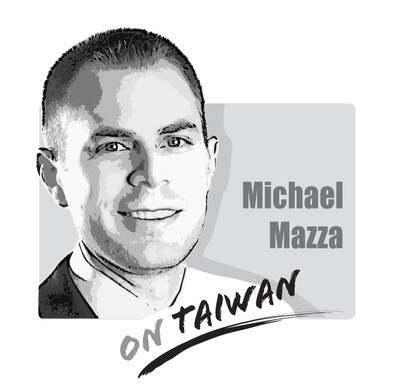Former president Ma Ying-jeou (馬英九) has reportedly said that the time for the anti-nuclear movement has passed and that restarting construction on the Fourth Nuclear Power Plant in New Taipei City’s Gongliao District (貢寮) is necessary to deal with Taiwan’s power shortage problems.
All Taiwan needs to do is fly in nuclear fuel rods, which would generate electricity for 18 months, Ma said.
This is one of several myths that members of the pan-blue camp are perpetuating. The Chinese phrase commonly used for describing the plan omits the word “construction,” and therefore erroneously implies that construction is finished and the plant is ready to operate. The question would just be whether to “reactivate” it.
Construction on the Fourth Nuclear Power Plant was not completed when it was mothballed, and it was the longest nuclear power plant construction project in the world. The budget was increased initially from NT$169.7 billion (US$6.12 billion at the current exchange rate) to NT$283.9 billion.
The project was initially divided into more than 1,000 separate projects, and has seen a budget freeze, redesign, construction problems, embezzlement, suspension and restarting of construction, and postponement. This Frankensteinian approach is a hazard itself.
Moreover, the biggest myth in the the pan-blue camp’s pro-nuclear power narratives relates to the plant’s location.
The world-leading science journal Nature in its April 2011 issue published a highly recommended article titled “Reactors, residents and risk” by staff writer Declan Butler, which reveals the relationship between the locations of nuclear power plants and population density. The main points are as follows:
First, two-thirds of the world’s nuclear power plants — 211 at the time — had more people living within 30km of them than Japan’s Fukushima Dai-ichi nuclear power plant, which had 172,000 living within that radius. Twenty-one plants had populations larger than 1 million living within that radius, and six had populations larger than 3 million.
Second, Pakistan’s Karachi Nuclear Power Plant had the most people — 8.2 million — living in its proximity, although it has just one relatively small reactor.
Taiwan’s nuclear power plants had the next-biggest populations living within 30km.
The Guosheng Nuclear Power Plant in New Taipei City’s Wanli District (萬里) had 5.5 million people within 30km, and the Jinshan Nuclear Power Plant in New Taipei City’s Shihmen District (石門) had 4.7 million, both with reactors many times larger than the Karachi plant.
Taipei is within 30km of both plants, which the article described as “scary.”
Third, reactor safety depends above all on a “culture of security,” including the quality of maintenance and training, the competence of the operator and the workforce, and the rigor of regulatory oversight.
Some Taiwanese nuclear power advocates are without a doubt “overconfident.”
James Carville, a political strategist of former US president Bill Clinton, coined the phrase “it’s the economy, stupid.”
Likewise, members in the pan-blue camp should consider the phrase “it’s the location, stupid.” Taiwan remains the only country with its capital and more than 5 million people living within 30km of nuclear power plants.
Does the Chinese Nationalist Party (KMT) wish that these 5 million people live in fear?
For the safety of Taiwan and its people, I will vote “no” on the referendum question on restarting construction on the Fourth Nuclear Power Plant.
Please join me in doing so.
Jerry Liu is the New Power Party’s international affairs department director and a former diplomat.
Translated by Rita Wang

Could Asia be on the verge of a new wave of nuclear proliferation? A look back at the early history of the North Atlantic Treaty Organization (NATO), which recently celebrated its 75th anniversary, illuminates some reasons for concern in the Indo-Pacific today. US Secretary of Defense Lloyd Austin recently described NATO as “the most powerful and successful alliance in history,” but the organization’s early years were not without challenges. At its inception, the signing of the North Atlantic Treaty marked a sea change in American strategic thinking. The United States had been intent on withdrawing from Europe in the years following
My wife and I spent the week in the interior of Taiwan where Shuyuan spent her childhood. In that town there is a street that functions as an open farmer’s market. Walk along that street, as Shuyuan did yesterday, and it is next to impossible to come home empty-handed. Some mangoes that looked vaguely like others we had seen around here ended up on our table. Shuyuan told how she had bought them from a little old farmer woman from the countryside who said the mangoes were from a very old tree she had on her property. The big surprise
Ursula K. le Guin in The Ones Who Walked Away from Omelas proposed a thought experiment of a utopian city whose existence depended on one child held captive in a dungeon. When taken to extremes, Le Guin suggests, utilitarian logic violates some of our deepest moral intuitions. Even the greatest social goods — peace, harmony and prosperity — are not worth the sacrifice of an innocent person. Former president Chen Shui-bian (陳水扁), since leaving office, has lived an odyssey that has brought him to lows like Le Guin’s dungeon. From late 2008 to 2015 he was imprisoned, much of this
The issue of China’s overcapacity has drawn greater global attention recently, with US Secretary of the Treasury Janet Yellen urging Beijing to address its excess production in key industries during her visit to China last week. Meanwhile in Brussels, European Commission President Ursula von der Leyen last week said that Europe must have a tough talk with China on its perceived overcapacity and unfair trade practices. The remarks by Yellen and Von der Leyen come as China’s economy is undergoing a painful transition. Beijing is trying to steer the world’s second-largest economy out of a COVID-19 slump, the property crisis and